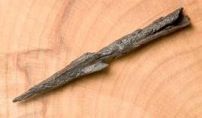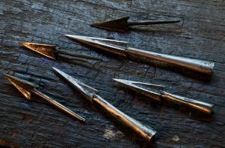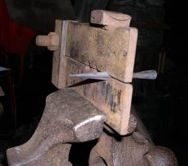Reproducing Roman Arrowheads

Roman arrowhead with three ribs from Dinorben, north Wales

Roman arrowhead with four ribs from Caerleon, south Wales

Replica arrowheads

jig used to form a four-vane arrowhead
The Romans used many different types of arrowheads. The most characteristic had a series of vanes: the early type had three vanes, but by the 3rd century examples with four vanes are found. One possible reason for this change is that the four-vane type was easier to produce.
In 2008 St Fagans National History Museum hosted the World Field Archery Championship, and the Museum held a number of small exhibitions on archery. A number of replica Roman arrowheads were produced especially for the Roman archery display, to show what Roman arrowheads looked like when new.
Careful conservation work on some of the Museum's Roman arrowheads revealed enough original surface detail to help us work out how the Romans had made them. The Museum's blacksmith at St Fagans was keen to produce the replicas in the same way, and he experimented until he could produce copies that closely matched the originals.
This experimental work revealed that the four-vane type was easier and quicker to make, as the vanes could be formed in a jig. The vanes on the three-vane type, being more spread out, had to be individually hammered into shape. While doing this one vane tended to get in the way of working on another. Was this why four-vane types started to be produced?
If this is true, why did the Romans start off with three-vane arrowheads? Roman archery equipment was based on that developed in the Near East. There, the original metal arrowheads had been cast in bronze. The three-vane form of these bronze arrowheads was simply copied when iron arrowheads started to be made.
Further Reading

Andrew Murphy, blacksmith at St Fagans National Museum of History using the jig to recreate Roman arrowheads
Bishop, M.C. & Coulston, J.C.N. 2006 Roman Military Equipment, from the Punic Wars to the Fall of Rome (Oxford: Oxbow Books)
Chapman, E.M. 2005 A Catalogue of Roman Military Equipment in the National Museum of Wales, BAR British Series 388 (Oxford)
Comments - (5)
I have copied the arrow head jig as much as I was able to. I have made the slots larger at the back end for the hevier part of the head and tapered the slots....... waiting for a smith made crank bellows to put it through its paces. Does the set-up sound correct to you? If I am in error in any way, could you please let me know.
Thanks for any information....... Mike Ware
Hi there Mozart,
Thanks for your enquiry - I will ask our blacksmith and let you know.
Best wishes,
Sara
Digital Team
Hi Daniel, have you tried looking at a Re-Enactors' Market? There are a few running in the UK according to google. They are really interesting places to visit, and to meet like-minded history buffs too!
Sara
Digital Team